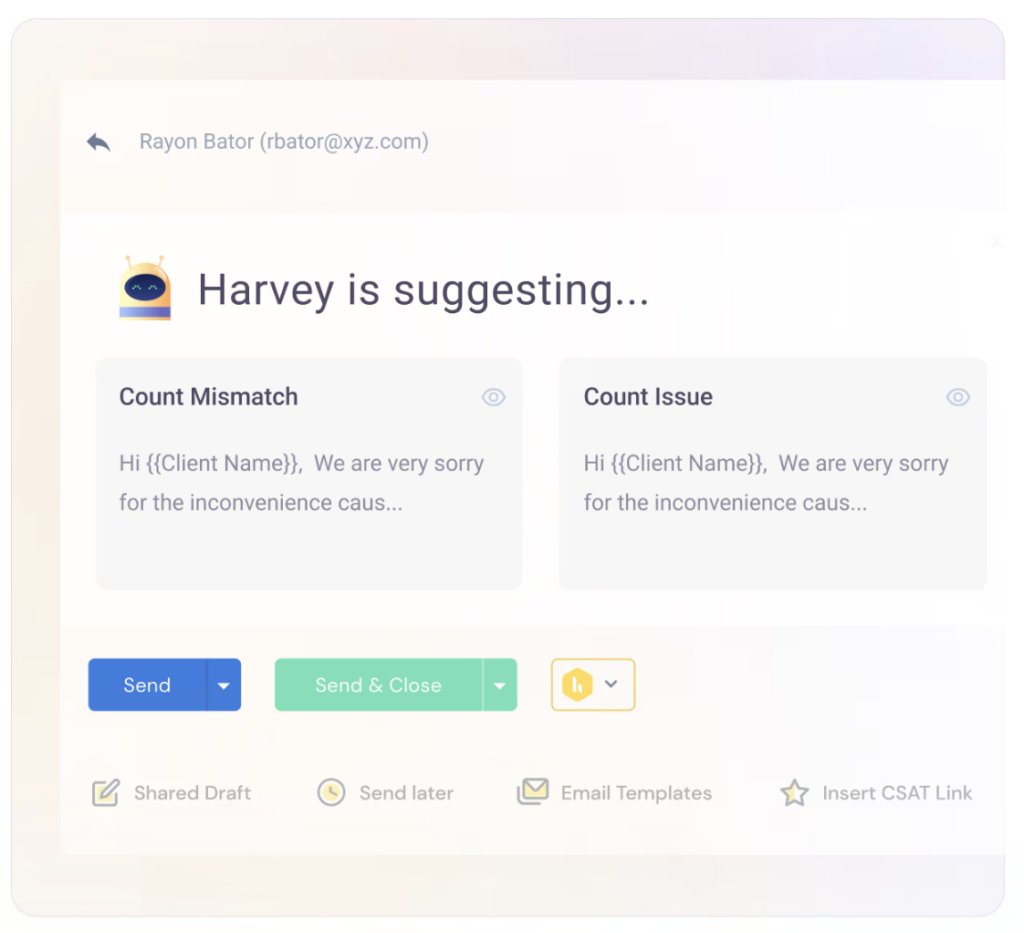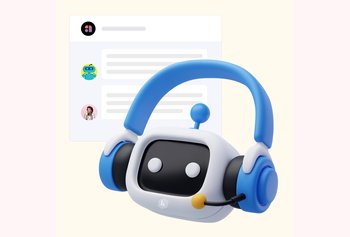15 Benefits of Chatbots in Customer Support

Table of contents
Chatbots have been a game changer in customer support owing to their ability to provide instant responses to queries and around the clock assistance.
What makes it even more appealing is that they bring down the cost of delivering exceptional support and can be continuously trained to offer better help with every interaction.
In this article, we discuss 15 benefits of chatbots in customer support and how they impact customers, employees, and businesses.
Table of Contents
- Benefits of Chatbots in Customer Service
- 1. Reduced workload for agents
- 2. Consistent responses
- 3. Personalization
- 4. Automate repetitive work
- 5. Easily scalable
- 6. Multilingual support
- 7. Improved lead generation
- 8. Multichannel support
- 9. Proactive support
- 10. Data collection and analysis
- 11. Customer feedback collection
- 12. Better A/B testing
- 13. Improved agent training
- 14. Reduced business costs
- 15. Streamlined customer service
- Make Your Customer Support Smarter with Chatbots
Benefits of Chatbots in Customer Service
Here is a comprehensive overview of the significant advantages of using chatbots in your customer support strategy.
1. Reduced workload for agents
One of the biggest benefits of chatbots in customer service is that they can be trained to handle repetitive queries from customers without involving a human agent unless absolutely necessary. Many chatbots are equipped with advanced algorithms that allow them to analyze the sentiment and intent behind a customer’s query.
They use this information to go through knowledge bases and other information sources to find the most accurate and contextual answer to the question and then shows it to the customer.
Here are some examples of queries that can be answered by a chatbot:
- Frequently asked questions on delivery, shipping, products, services, or pricing
Some frequently asked questions that can be answered by a chatbot:
-‘Where is my order?’
-‘Can you tell me more about <product name>?’
-‘How long does delivery take?’
-‘What is your return policy?’
-‘How do I reset my password?’
- Account-related information such as balance, transaction history, settings, or subscription details
- Basic troubleshooting steps to resolve technical issues or common complaints with a product or service
- Policy information on refunds, returns, terms of service, or warranty coverage
- Reservation or booking confirmations
2. Consistent responses
Chatbots are trained through pre-defined scripts and rule-based logic. In most cases, they are also integrated with a knowledge base. These bots follow standardized guidelines to interpret a customer’s query, pull up relevant information, and deliver accurate responses.
This ensures that chatbots deliver information consistently across customer interactions regardless of the channel
3. Personalization
Did you know that Starbucks has a chatbot that is built into their mobile app? Customers can place orders, make payments, and get answers to queries regarding menu items. Interestingly, the chatbot can also offer you personalized recommendations for drinks based on your preferences.
There are many examples where chatbots can be leveraged to offer tailored recommendations to customers. Chatbots analyze data from past purchases, conversation histories, preferences, and demographics to create a comprehensive user profile. They can use this data to personalize responses and suggest recommendations, improving customer engagement.
They can even use this data to track a customer’s engagement patterns and run targeted ad campaigns across a user’s preferred channel such as WhatsApp or Facebook Messenger.
4. Automate repetitive work
nother advantage of using chatbots is that they reduce the average response time associated with customer queries.
Chatbots do this by automating repetitive tasks that would otherwise unnecessarily consume an agent’s bandwidth.
For instance, Hiver’s AI bot – Harvey helps support agents to be more productive in the following ways:
AI summarizer: Agents may have to go through long email threads and conversations to get to the root of a customer problem or the status of a ticket. This can make it difficult to track escalations and deliver quick responses.
Harvey summarizes long email threads into concise, easy-to-grasp summaries that allow stakeholders to get a quick overview of what actions have been taken on a ticket.

Intelligent email templates: Harvey can suggest email templates by analyzing a customer query and identifying the best response for the particular email. Agents do not have to spend time sifting through available templates or composing replies to common queries.

5. Easily scalable
Businesses can experience peak traffic periods during certain times of the year. For instance, e-commerce businesses almost always have to deal with a huge volume of customer queries during holiday seasons.
Support teams may struggle to keep up with this influx of queries and it really doesn’t make sense to scale teams just during these periods. This is where chatbots can help.
Chatbots are highly scalable and can handle multiple customer conversations at a time. This ensures smooth operations without additional resources. This is a much more cost-efficient alternative to handling higher volumes of queries and it is easily scalable.
Chatbots can provide instant responses to most Level 1 queries.
Level 1 queries are basic, routine queries that can be resolved without a lot of in-depth technical expertise. Some examples of Level 1 queries include:
-‘How do I reset my password?’
-‘Where is my order?’
-‘Is <product name> available at your <location> store?’
-‘What payment methods do you accept?’
In cases where the queries are more complex, chatbots can seamlessly loop in human agents and provide them complete context into the customer’s complaint.
6. Multilingual support
Chatbots use advanced algorithms to detect the language in which a customer is conversing when they initiate a conversation. This allows them to understand the intent behind a conversation, enabling chatbots to engage with customers in multiple languages and provide instant responses.
One of the biggest advantages of this approach is that brands can offer native language support to users, improving customer satisfaction without having to spend on costly translation services or additional agents.
You Might Also Like: How AI Enhances Traditional Knowledge Base
7. Improved lead generation
Many businesses use chatbots as an integral part of their lead qualification strategy. These bots are trained to ask targeted questions that can help understand their specific needs, level of interest, and fit.
For instance, say a visitor lands on the website of a real estate company and starts interacting with their web-based chatbot. The chatbot collects information by asking questions about the location, type of property, budget, and contact information.
The chatbot then assigns a lead score based on certain pre-defined criteria and determines whether the visitor is a qualified lead. Agents can follow-up with the website visitor based on this information.
8. Multichannel support
Chatbots can be deployed across websites, mobile applications, and messaging platforms enabling businesses to offer multichannel support. This way customers can engage with chatbots on their preferred channel.
The chatbots centralizes customer data irrespective of the channel the user prefers, enabling a consistent and cohesive user experience.
9. Proactive support
A chatbot can engage with customers and offer assistance even before they need it.
For instance, say a customer has been browsing a website for a laptop. They’ve added it to their cart but have not completed the purchase.
Chatbots can proactively reach out to the customer and offer assistance with the purchase by answering any questions they may have. They can also seamlessly hand-off any queries the customer may have to a human agent which may improve the chances of a conversion.
10. Data collection and analysis
Chatbots can collect detailed customer information along various aspects such as purchase behavior, transaction history, preferences, and demographics. Chatbots can use this information to segment customers and identify trends or patterns in their behavior. This can help businesses predict future customer behavior, reduce customer churn, and understand engagement patterns. Chatbots can also help map out a customer’s journey and identify the various touchpoints and roadblocks. Businesses can proactively take corrective measures and identify opportunities for optimization.
11. Customer feedback collection
You can use chatbots to collect feedback from customers through conversation prompts or feedback surveys. This allows businesses to gather insights into their experience and satisfaction with a product or service.
Chatbots can even analyze customer sentiment from their feedback and gauge satisfaction levels. They do this by processing a customer message to remove special characters, stop words, and punctuation. The remaining text is broken down into individual words. Chatbots then use sentiment analysis to analyze these words and phrases and identify important signals. The sentiment of the text is then classified as positive, negative, or neutral based on the customer’s experience.
12. Better A/B testing
Chatbots can help businesses with A/B testing to understand what kind of message resonates most with their target audience.
They can be programmed to deliver variations of a message to different segments of audience to test the effectiveness of content formats. Chatbots deliver these content formats randomly based on experimental conditions. Data on engagement levels, conversions, and response rates is then used to track the performance of these message variations.
13. Improved agent training
Use chatbots to onboard and train new agents. You can deploy chatbots on your employee training platforms so that they are available to assist new employees whenever they have questions regarding a process.
Chatbots can pull up information from your knowledge base and internal resources to allow employees to learn more about product features and policies without having to rely on their managers or trainers.
14. Reduced business costs
Chatbots can handle routine queries, offer multi language support, and automate repetitive tasks. Although there is some significant investment when setting them up, chatbots help your business save money over time.
Using chatbots reduces the need for additional support staff or agents. They also reduce training costs for onboarding new employees and can be scaled up or down depending on your business requirements.
15. Streamlined customer service
Agents often handle an influx of customer queries and at times it can get overwhelming. A huge volume of incoming requests means support agents do not have a lot of time to see which queries need to be escalated or prioritized.
Chatbots can do an initial triage of incoming queries. They can assess a query and classify it according to type, priority, or language. Queries that require simple and straightforward responses receive automated responses while other, more complex queries are routed to agents based on certain conditions.
In such cases, the chatbot collects critical information from the customer and uses it to offer agents all the context they need to offer the right kind of support.
This reduces agent workload and improves their efficiency since they can direct their focus on truly helping the customer.
Make Your Customer Support Smarter with Chatbots
Integrating chatbots into your customer support strategy can help you tackle a wide range of customer queries and conversations without overwhelming your support team.
Chatbots can continuously learn from each interaction and improve their responses over time, making your support smarter and more effective. They leverage natural language processing (NLP) and machine learning to understand the context of a customer’s query and deliver seamless support experiences.
With chatbots, your customer support becomes more efficient, responsive, personalized, and scalable. This allows you to better cater to your customers and build stronger relationships with them.

































